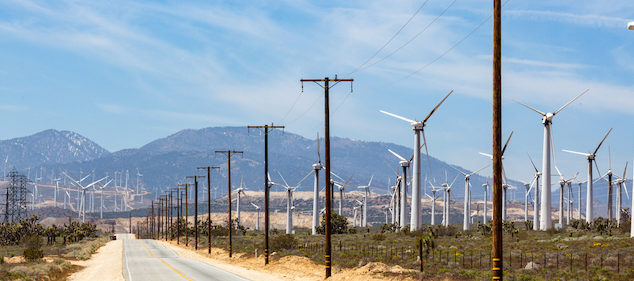Opinion
Reliability is crucial to California’s electricity grid
 California wind turbines provide electricity carried through nearby power lines.
California wind turbines provide electricity carried through nearby power lines. (Photo: Mark Higgins, via Shutterstock)
As finger-pointing continues over California’s rolling blackouts, some are trying to pin the blame to renewable energy. They are wrong. It’s clear that California’s ambitious renewable energy efforts were not at fault.
But reliability is an urgent concern. So it is worth talking about strategies that ensure that electricity is always flowing on the grid, while also enabling California to shift to 100% clean energy faster than planned and at a lower cost than currently anticipated.
In our recent white paper “Path to 100% Renewables for California,” global energy company Wärtsilä shared computer modeling results showing that the state’s most affordable, fastest, and most reliable path to 100% clean energy involves expanding wind and solar generation and battery-style energy storage, retiring legacy gas plants, and adding fast-starting, flexible-generation power plants.
These flexible plants can run on gas now, switching on and off as many times a day as needed to seamlessly complement variable wind and solar generation. And they are convertible — able to run on synthetic fuels produced from excess renewable generation, including carbon-free hydrogen and carbon-neutral synthetic methane — as those nascent technologies become more widely available.
Flexible generation running on synthetic fuels from renewable power plants would complete California’s renewable picture, making 100% renewable electricity realistic, affordable, and extremely reliable.
During the blackouts California’s thermal assets were running. What does that tell us?
It tells us California needs flexible thermal coupled with renewable fuels, which acts as a form of long-term storage (days to weeks, not hours). Having this capacity available and the proper long-term storage will allow our state to ride through periods of high demand and reduced solar and wind generation, even during drought years.
Reaching 100% renewables would then require California to retire old, inefficient and inflexible fossil assets, and replace them with renewables, energy storage, as well as strategic amount of flexible, efficient thermal that is capable of moving from fossil fuels to renewable fuels.
“Path to 100% Renewables for California” analyzes several approaches to decarbonizing the state’s electricity. It finds that renewables plus battery storage plus flexible generation would enable the state to meet its goal of 100% clean electricity by 2040, which is five years ahead of current targets.
Compared to California’s current plans, this “optimal path” would involve emitting 124 million fewer tons of carbon dioxide, using about one-third less land for solar and wind development, and providing $8 billion in savings.
Plus, this approach allows our state to reach carbon neutrality (per IPCC requirements) while retaining 32 GW of thermal capacity with existing fuel storage that’s capable of holding enough stored renewable energy, in the form of fuel, to power that capacity for 67 days.
Recent weather events have emphasized the need to focus on solutions that can be deployed today. Rather than an either/or situation, California can choose a both/and approach by continuing its deployment of solar plus storage and updating its clean electricity mandates to formally recognize thermal power plants running on renewable fuels — including methane and hydrogen produced with excess solar and wind energy — as renewable and net-zero-carbon generation.
By deploying optimal amounts of solar, wind, battery storage, and fast-start, flexible thermal generation, California can retire all of its once-through-cooling power plants by 2023, run on 100% renewable electricity by 2040, and save land and money while building a clean energy future.
—
Editor’s Note: Andrew Tang is Wärtsilä Energy Business’s vice president for Energy Storage and Optimization.
Want to see more stories like this? Sign up for The Roundup, the free daily newsletter about California politics from the editors of Capitol Weekly. Stay up to date on the news you need to know.
Sign up below, then look for a confirmation email in your inbox.

Leave a Reply